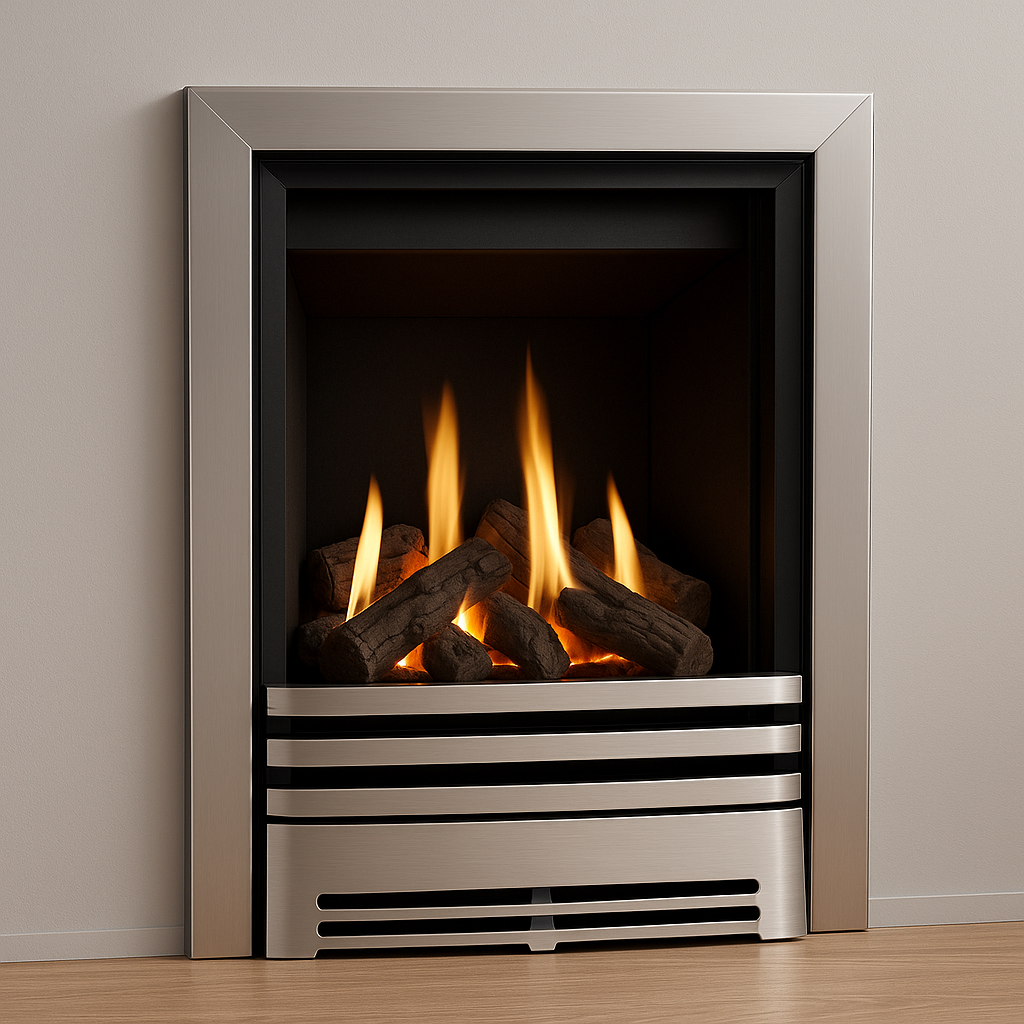As the UK battles rising energy bills, many homeowners are looking for efficient & cost-effective ways to keep warm without sending their gas or electricity usage through the roof. One option that often raises eyebrows is the flueless gas fire. With no chimney, no flue, and no traditional ventilation system, it’s natural to wonder: do flueless gas fires really work?
The short answer? Yes, they do—brilliantly. But, as with any heating solution, it’s important to understand how they function, their benefits, and whether they’re the right choice for your home.
Let’s break it all down.
1. What Is a Flueless Gas Fire?
A flueless gas fire is exactly what it sounds like—a gas fireplace that doesn’t require a chimney or flue to operate. Instead of venting waste gases outside, these fires use an advanced catalytic converter to clean the emissions, ensuring that only safe, breathable air is released into your home.
Think of it like the catalytic converter in a car—except this one is keeping your living room warm, rather than reducing emissions from a motorway journey.
How Do Flueless Gas Fires Work?
🔥 They burn natural gas or LPG (liquefied petroleum gas).
🔥 A built-in catalyst system converts carbon monoxide into harmless carbon dioxide & water vapour.
🔥 The fire produces 100% heat efficiency—since no warmth is lost through a chimney.
🔥 An oxygen depletion sensor (ODS) ensures safe operation, automatically shutting off the fire if oxygen levels drop too low.
These fires are designed to meet strict UK safety regulations, meaning when installed & used correctly, they are completely safe and highly efficient.
2. Do Flueless Gas Fires Give Off Enough Heat?
Absolutely! In fact, flueless gas fires are among the most efficient heating options available.
Because they don’t lose any heat through a chimney or flue, they offer 100% efficiency, meaning every bit of warmth stays in the room. Most models range from 1.5kW to 3.5kW output, which is plenty to heat a medium-sized room without needing to crank up the central heating.
How Do They Compare to Other Fires?
| Fire Type | Efficiency Rating | Heat Output |
| Open Fire | 20-30% | High heat loss |
| Standard Gas Fire | 50-70% | Moderate |
| Flueless Gas Fire | 100% | Strong heat output |
| Electric Fireplace | 100% | Lower but consistent |
If your main goal is keeping warm while using less energy, a flueless gas fire is one of the best options on the market.
3. Are Flueless Gas Fires Safe?
A common misconception about flueless gas fires is that they are dangerous because they lack a flue. In fact, they are designed with multiple safety features to ensure they operate securely in British houses and homes.
Key Safety Features:
✅ Catalytic Converter – Cleans emissions to ensure no harmful gases are released.
✅ Oxygen Depletion Sensor (ODS) – Automatically shuts off the fire if oxygen levels drop too low.
✅ Thermostatic Control – Prevents overheating.
✅ Strict Installation Guidelines – Must be fitted by a Gas Safe registered engineer to ensure safe use.
The catalytic technology used in these fires is tested to last at least 15 years, making them a safe & reliable long-term investment.
4. Where Can You Install a Flueless Gas Fire?
One of the biggest advantages of a flueless gas fire is that it can be installed almost anywhere—even in homes without a chimney.
Common Installation Areas:
🏠 Living Rooms – A sleek, contemporary heating solution for your main living space.
🍽 Dining Rooms – Adds warmth & ambience for cosy family meals.
🛏 Bedrooms – Some models are approved for use in bedrooms, providing gentle overnight heat.
🏢 Apartments & Flats – Perfect for properties where chimney installation isn’t an option.
Installation Requirements:
🔹 The room must have adequate ventilation (e.g., an air vent).
🔹 Minimum room size required (varies by model, usually 23-30m³).
🔹 Must be installed by a Gas Safe registered engineer.
Proper installation and adherence to guidelines ensure maximum efficiency and safety.
5. What Are the Pros and Cons of Flueless Gas Fires?
Like any heating solution, flueless gas fires come with advantages and limitations.
✅ Pros:
✔ 100% Efficiency – No heat lost through a chimney.
✔ Lower Running Costs – Uses less gas than traditional fireplaces.
✔ Flexible Installation – Can be placed almost anywhere.
✔ Eco-Friendly – Lower carbon footprint compared to open fires.
✔ No Chimney Required – Ideal for modern homes & apartments.
❌ Cons:
❌ Room Size Restrictions – Not suitable for very small, unventilated spaces.
❌ Ventilation Requirement – A small vent is needed to ensure airflow.
❌ Limited Heat Output – While efficient, they may not heat very large rooms effectively.
For most UK homes, especially energy-conscious households, the pros far outweigh the cons.
6. Are Flueless Gas Fires a Good Investment?
If you’re looking for a low-maintenance, high-efficiency, and cost-effective way to heat your home, then yes—flueless gas fires are an excellent investment.
✔ They provide immediate warmth without wasting energy.
✔ They offer modern, stylish designs that suit contemporary interiors.
✔ They reduce heating costs, particularly in well-insulated homes.
With energy prices still unpredictable, choosing a fireplace that delivers 100% heat efficiency can save money in the long run.
7. Conclusion: Should You Buy a Flueless Gas Fire?
So, do flueless gas fires really work? Yes—brilliantly.
They provide powerful, efficient, and safe heating with the flexibility to be installed almost anywhere. While they require proper ventilation and professional installation, they offer one of the most cost-effective and environmentally friendly ways to heat a home in the UK.
If you’re tired of feeling the chill this winter and want a heating solution that works efficiently without wasting energy, a flueless gas fire could be exactly what your home needs.
🔥 Stay warm, stay efficient, and embrace the future of home heating.

No responses yet